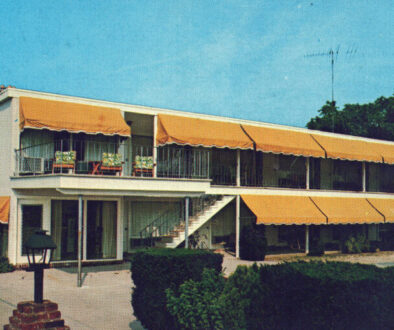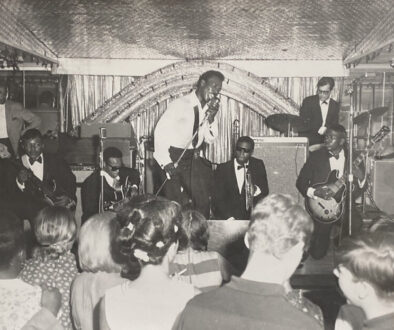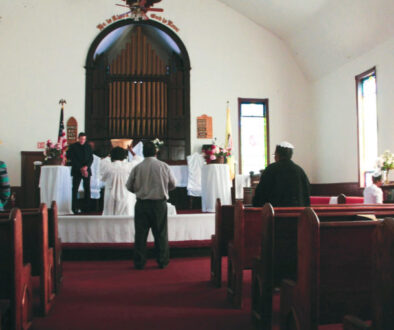A Place to Stay
Cape May has never been a legally segregated city. No laws mandating racial separation have been found among the city’s records, nor signs unearthed from its past that read “No Colored.”
And yet, from the 1860s until 1948, there was a white elementary school and a black elementary school. Beaches were segregated by custom. And from the Victorian era until the 1960s, six hotels catered only to African American guests. For the most part, black visitors spent their summer holidays as their white compatriots did: going to the beach, eating good, fresh food at hotel dining rooms—but probably not many restaurants—enjoying entertainment by musicians and other performers, and the simple pleasure of sitting on porches in companionship with other hotel guests.


Earliest among these hotels was Banneker House, on the corner of Lafayette and St. John Streets. From about 1855, members of Philadelphia’s Banneker Institute as well as other guests, mostly from Philadelphia, would spend summer vacations there, escaping the unpleasant city heat. The two institutions, while not named after each other, were both named for the 17th-century free black mathematician, scientist, and abolitionist, Benjamin Banneker.
The Banneker Institute was organized in Philadelphia in 1854 to—among other purposes—unify the city’s black community. Members met weekly from September through June for lectures and discussions aimed at intellectual stimulation and nourishment, according to Emma Lapsansky’s article, “Discipline to the Mind: Philadelphia’s Banneker Institute, 1854–1872.” Membership was exclusive, and required discipline, dignified behavior, including a prohibition against “indecorous language,” and rigorous adherence to all the organization’s rules. The founders were involved in the abolitionist movement and the fight for civil rights for already-free blacks.
In 1855 Banneker Hotel guests—led by George T. Burrell—president of the Banneker Society, organized a celebration honoring the freedom of blacks in the West Indies. This article, “FIRST OF AUGUST CELEBRATION” appeared in the publication Frederick Douglass’ Paper on August 14, 1855:
“At a large meeting of the Colored Visitors and others, held at the Banneker House, Cape Island, on Wednesday, August 1st, to celebrate the Anniversary of the Emancipation of 800,000 slaves in the British West Indies. . .
“Resolved: That we hail with delight the anniversary of the day that gave freedom to 800,000 of our brethren in the British West Indies.
“Resolved: That we lament that the United States, although boasting of her liberty and republicanism, still hold in slavery 3 1/2 millions of our brethren, thus demonstrating to the world its great inconsistency and injustice.
“Resolved: That it is the indispensable duty of our people to use every effort for the overthrow of slavery, and for the acquisition of our rights in this the land of our nativity.
“Resolved: That the awakened spirit of freedom that is rising in majestic splendor throughout the North, East and West, proclaims in thunder tones, that the days of chattel slavery are numbered and that posterity will be summoned to the consecration of an event which will shine far more illustrious in history than the one we have met this day to celebrate. It will be the redemption of millions of bondmen from the despotism power of the slave oligarchy of the South. It will be the annunciation of that auspicious period when the Sun of freedom’s God will only dispense her luminous rays on a land consecrated to the genius of universal freedom.”

Near the end of the 1869 resort season, distinguished guests organized an informal meeting and presented Banneker’s manager, Mr. Richard H. Gleaves and his “lady” with an effusive resolution of praise. “We recommend the Banneker House to our people throughout the country as being, as we know from experience, the only summer resort where we can enjoy the same rights and privileges (unmolested) patronized and supported by our citizens generally.” The resolution added the hope “a beneficent Providence ever bless them in health, happiness, business success, and length of days.”
Remarks following the resolution were made by Reverend Stephen Smith, one of the wealthiest men in America, whose small summer house still stands at 645 Lafayette Street. Smith, with three other Philadelphia businessmen, owned Banneker House and several other properties in Cape May. With his relative and partner, William Whipper, he also owned a prosperous coal and lumber company that used a fleet of boats and railroad cars to move products throughout the region. Smith was engaged in the work of the Underground Railroad headquarters in Philadelphia, and he and Whipper used the fleet to carry escaping slaves to freedom.
Banneker House continued operating well into the 20th century. The building was demolished during Cape May’s urban renewal period in the 1960s.
Into the mid-20th century, five more hotels continued to exclusively serve black guests. The DeGrif Hotel sat in the middle of the three blocks of Corgie Street from about the early 1940s until the mid-1960s. The building was demolished and replaced in the 1970s (and another building replaced that one in 1994).
Corgie has been called “the sandwich street” because until the 1960s the two end blocks housed white residents, while in the middle block were black families. The DeGrif was at 827 or 829, according to the memories of Shirley Rebecca “Becki” Wilson, who grew up across the street. Her mother’s cousin’s family, headed by Helena Griffin—called “Aunt Helena” by Wilson and her family—owned it.

Whether there were hotel owners before that remains a mystery. “I know they owned it in the 1940s and early ’50s. I remember her, and her mother—we called her Aunt Del.” From Wilson’s childhood in the early ’40s, “It had always been there.”
The DeGrif was a popular gathering place for Cape May musicians, who would meet at DeGrif organized events and sometimes jam through the night after finishing gigs around town. Lois Smith, who grew up in her mother’s guest house, Brown’s Cottage on Lafayette Street, was sometimes part of those events. “I was very young, but I was fresh,” she laughs. She sometimes sang with the bands, even though she was only 12 or 13.
Black musicians traveled from Philadelphia. One was Tommy Potter, whose mother, Miss Negron, lived in Cape May; his wife was friends with other locals. Potter would post notices around town announcing the programs.
The musicians organized affairs for wedding receptions, dances, and group parties that celebrated everyone who had a birthday in a given month. Lois Smith recalls one May party because that’s her birthday month, along with several other celebrants. “Lucy Brown and I were both on May 20. It was a big party, with food and music.” Church socials and benefits, dances, and fashion shows were all held in the DeGrif’s huge banquet hall.
“It was a big place,” Becki Wilson recalls. “You walked in, there was a bar on the side with real old marble-top tables, and then you’d walk in the back and there was the kitchen. We’d go back there and talk.” And apparently enjoy refreshments. “Aunt Helena’s favorite drink was milk and scotch.”
In the late ’40s, according to Wilson, guests were mostly college boys from southern black universities who came here for summer work in the larger hotels. “It was like a ritual; the boys would come and stay there and go work at the Colonial. I remember when I was 12 years old, I had a crush on one of the boys.” Alas, she was too young to date.
Wilson’s mother and grandmother, from another branch of the family, worked at the Hotel Macomber as chambermaids during this period. “I remember Aunt Del sitting on the front porch in her rocking chair—they had rockers on the front porch. My grandmother—my mother’s mother—lived at 801 Queen Street” in a house built in 1900 that still stands on the corner. “My sister and I would run—we didn’t walk, we ran!—to my grandmother’s house, and I remember seeing them sitting on the porch [of the DeGrif].”
A small brick building at the corner of Lafayette and Jefferson streets is all that remains of Hotel Dale, elegant and prestigious lodging “for the accommodation of the Afro-American,” said its promotional brochure, reproduced with an introduction and memoir in 1993 by the late John Nash. Mr. Nash collected local history; his photographs and memoirs are now housed in the John and Janet Nash Archives of African American History at the Center for Community Arts.
The flyer touted “the comfort and elegance of its furnishings,” complete with “all modern improvements; mechanical and electrical.” The hotel was “centrally located on the highest point in Cape May Golf Club links.” Guests were assured that they could view the games “daily during the season from the veranda.” Note, however, that guests were not invited to actually play the game.

The Cape May Golf Club was on then-open land behind Lafayette Street, its headquarters in a still extant building on Lafayette. Its seasonal pro was William Moore, superintendent of the West Cape May elementary school for black children.
The brochure goes on: “Attached to the hotel are fifty sleeping chambers and ten baths. Each room is tastefully and comfortably furnished and equipped with hot and cold running water with long distance telephone connection. Suites with bath. These rooms are kept to meet the sanitary condition of the most perfect home.”
A photograph of a bedroom shows simple furnishings: a bed with what is probably a brass headboard, a bedside dressing table and chair, and a tall bureau, both with mirrors. An open door shows a bathtub, so we can assume this is a “suite.” Hotels then were described as luxurious, but the rooms were plain, intended for comfortable sleeping and not much else, since visitors to the seaside were more interested in going to the beaches and socializing at the hotel and around the city. Hotel Dale had a private orchestra and, typically, a reception room where guests could gather for “enjoyment and pleasure.” A lawn accommodated tennis, croquet, and other outdoor games.
The hotel began life in 1850 as Whitehall Hotel, owned by Dr. Samuel Sumner Marcy, who lived in the brick house. In those days it accommodated white guests. Edward Dale, an African-American who owned an auditorium on Jackson Street and several other properties, bought it in 1911. The four-story main hotel reached north from the brick house nearly to the corner of Jefferson Street. It was demolished in 1936, a few years after Dale sold the hotel and moved away.




Several buildings ran behind, on what was then Whitehall Court, but became—and still is—Dale Place. John Nash was born at 818 Jefferson, on the corner of Dale Place, and later lived with his family in the brick house. When he came back to Cape May after serving in World War II, he and his wife, Janet, bought the land previously occupied by the main hotel and built a motel they called The Planter, after a Confederate ship confiscated by Janet Nash’s famous ancestor, Robert Smalls. They sold the motel in 1979; today it is Cape Winds.
Hotel Dale retains its historical cachet, commemorated for accommodating several famous African American leaders. In 1915 Dr. W.E.B. DuBois, co-founder of the NAACP, was honored at a dinner at Hotel Dale. Toastmaster was Dr. Edgar Draper, a popular African American physician with offices on Jefferson Street. (A passageway off the Washington Street Mall is named for him.)
The Cape May Gazette wrote in a 2012 article, “The newspaper the Washington Bee described the DuBois event as an ‘occasion that will long be remembered.’ Then it gave a plug for the place where it was held: ‘Hotel Dale is one of the best resorts on the Atlantic and when guests come here they are royally treated.’ ”
Ever the enterprising businessman, Mr. Dale advertised as far away as Nashville, Tennessee, and collected testimonials from some of his patrons:
Dubois wrote: “I have always enjoyed my visits to Hotel Dale.”
Dr. Booker T. Washington: “Speaking of the service rendered our touring committee, your hotel afforded unusual comfort and convenience.”


Levi Coppin, editor, educator, missionary and the 30th Bishop of the African Methodist Episcopal (AME) Church: “For service and comfort, Hotel Dale is unexcelled and the prices are in keeping with the service. The enterprise is in response to the long-felt need among our people, and deserves a most liberal patronage.”
Rooms at Hotel Dale ranged from $1 to $3 a day. Prices for suites with bath are not listed.
The only other black-owned hotel whose structure remains was The New Cape May Hotel, popularly called “Richardson’s” after its owner, Harry Richardson. The building is on Jackson and Broad streets and now houses several retail stores. In addition to typical accommodations, there was a restaurant and bar on the ground floor.
An article in the 1919 edition of The National Encyclopedia of the Colored Race describes the life of Harry Richardson, owner of the hotel.
“Known as the friend of all colored people who seek pleasant lodging and wholesome food at Cape May, New Jersey, Harry Richardson, proprietor of the New Cape May Hotel…began an apprenticeship at electroplating and stereotyping…” Richardson continued that work in Boston, eventually buying and managing The New Cape May Hotel, and another building on Jackson Street known as the Opera House, a popular entertainment venue for Cape May’s black community.

Richardson owned the block that now includes Ocean First Bank up to Broad Street and his hotel. The Opera House stood on the current bank property.
“He saw the crying need of a good hotel for the Colored Man,” continues the article, and “he attempted to supply that need in his locality. In doing this he has served his race while helping himself. Again he saw the need of a place where the best people could go to get clean amusement and again he attempted to supply that need. In this he has succeeded. Both his places of business are very heartily supported by his patrons. His hotel is celebrated…for comfortable rooms, prompt and polite service, the best class of guests, and the most congenial surroundings.”
Because “Blacks had no access to movie theatres,” notes Lois Smith, Mr. Richardson would arrange for popular movies to be brought to the hotel, setting up a large screen in the dining hall on Friday nights to show movies that varied from professional boxing matches and ball games for the grownups, to the latest Shirley Temple film and Snow White and the Seven Dwarfs.
The neighborhood bounded by the corner of Lafayette and Jackson streets, west to Broad Street then around the corner along Broad to Elmira was the center of a mostly African American business district until urban renewal projects demolished most of the structures beginning in the mid-1960s. The only buildings still standing from that era are Collier’s Liquors and the former New Cape May Hotel. Until the 1950s, the Douglas Hotel occupied the curve in the road where Lafayette ends and blends into Jackson.
Records from before that building disappeared to be replaced by an Exxon gas station are elusive. But some people who grew up nearby remember the Douglas’ unfortunate nickname, The Bedbug Inn. Not necessarily because the hotel itself was infested, says long-time local Emily Dempsey, but because bedbugs were so common that when the trucks spraying DDT (yes, alas) traveled through most of the city’s streets, residents and business owners opened their windows to allow the toxin to destroy pests that were “prevalent everywhere.” Remember that these were the days before Cape May’s revival, and many of the city’s structures were in very bad shape. Lois Smith points out that there were ponds throughout the golf course and farms in West Cape May with rotting manure, so the pest population was far more varied than the simple little bedbug; mosquitoes and big nasty black flies plagued the whole area.
Adding to accommodations for African American tourists were several guest houses. Gibson House was among the businesses in the area that is now Rotary Park. On Lafayette Street, surrounding Brown’s Cottage, were one owned by “Slick” Lewis, who had a candy store on the first floor, and Green’s Cottage. “They were big houses,” say Lois Smith; she says Brown’s Cottage was the biggest, with a total of 32 rooms.

School segregation in Cape May ended in 1948. While African Americans had been discouraged from playing at beaches other than Grant Street—where there was a black lifeguard—that practice gradually faded. Neighborhoods that had been predominantly black became less so, partly because many African Americans simply left town after urban renewal. Before the mid-20th century the black population on Cape Island was about 30% of the total; today it is about 3%.
We often think of Cape May’s history as the Victorian era, when it became famous. But think about this: except for Banneker House, these black-owned segregated hotels were part of 20th-century Cape May. Many of the readers of this magazine were alive—many were adults—when racial separation was part of Cape May’s society. Not that we are unique; the practice was not unusual in the north, less cruel and blatant than southern lawful segregation, but still present.
The story of segregation brings us well into modern history, when African Americans worked and owned businesses, but were “invited” off most beaches, and when they were seated only in the balcony of the Liberty movie theatre on Washington Street. By the end of local urban renewal in the 60s and early ’70s, all the black-owned hotels were gone. And Cape May has generally moved beyond; we are now home to people from everywhere on the planet. As we celebrate this area’s rich and entertaining history, we should honor all of it—some of it not so pretty, but an important element to the town’s welcoming climate to all people.



